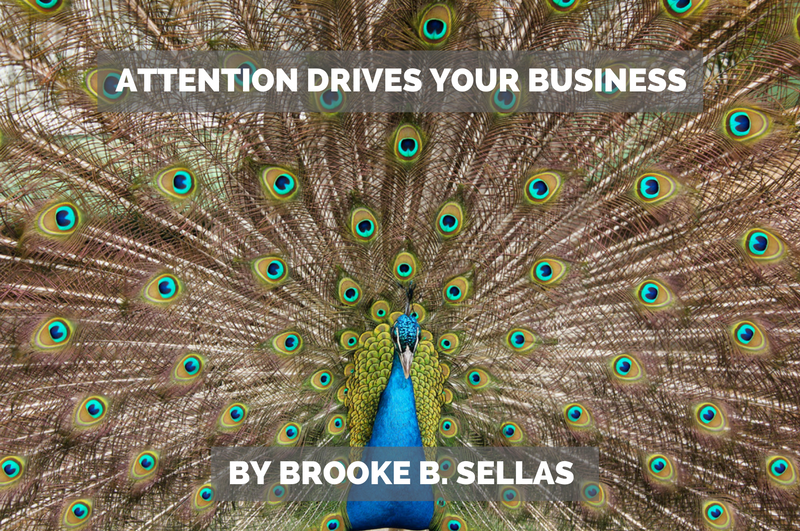By Brooke Sellas, {grow} Contributing Columnist
We’re living in the age of the Attention Economy.
Let me rephrase that: We’re still living in the age of the Attention Economy.
Nearly 15 years ago, a book on The Attention Economy was published announcing the importance of managing attention for business and branding.
And we’re still here. Facebook’s most recent algorithm change emphasizes this by stressing shares on their network.
Why shares? Because shares indicate attention, and attention is why consumers spend 50 minutes a day on the mega platform — more than any other leisure activity.
So how can your content marketing efforts garner the much-needed attention that seems to be driving things these days?
Understand YOUR Attention Economy
Mark Schaefer recently wrote about the importance of knowing where your audience is.
He says, in short:
“Maybe it doesn’t matter if we’re on Snapchat or Facebook Live. What matters most is where our customers want to be found, where they want to engage.”
Audience Development and understanding where your target audience spends their time and attention is essential to getting your content seen.
We’re busy, we’re choosy, and we need something to catch our attention quickly — all reasons the Attention Economy is alive and well.
Most businesses have no idea:
- Where their audience is online
- How their would-be clients ask for advice/help online
- Why potential clients and clients keep spending time with their content (or don’t)
While marketers are busy creating content about product features, they’re losing out on understanding what information their consumers want to consume (which is typically the outcome of those features, or experiences) and where their audience wants to consume this content.
So how do we put ourselves in an Attention Economy mindset?
5 Musts Of The Attention Economy
1) Attention
For obvious reasons, you need to understand the who, how, where, what, why of attention.
- Who are you trying to gain the attention of?
- Where are these people spending time online?
- What types of content are they consuming on these sites, and why?
- How can you imitate success and produce catchy content on these sites?
Bottom line, unless you’re in tune with who your messages should be targeted at it’s going to be hard to garner attention.
2) Permission
Once you figure out how to gain the attention of your desired audience, you need to get permission to market to them on other channels.
Like email.
Marketing open rates are about 18% but without permission, they’re much, much lower.
Case in point, we recently ran a campaign for a client where we purchased a cold list to send emails to. Our open rate was an abysmal 2%.
This is why permission is so important in the Attention Economy — without it, you can lose out on 16% of your audience!
Even if permission is as simple as someone following you on Twitter, you now have a better chance of being seen.
3) Engagement
Whether or not you’ve decided to go after permission early in your attention quest, engagement is also an important element when after attention.
Engagement says, “I saw this AND I’m interested in it.”
Whether that interest is a click, comment, share, or “like” is important, too. As we talked about earlier, and as Facebook is now underscoring, shares help distribute your content to people who may also be in your target niche, but whom you may not have yet targeted.
Engagement plays into one of the most important key performance indicators with content right now: time spent.
4) Trust
It’s not enough to grab attention and get a share or two in the Attention Economy. It goes much deeper than that.
To keep your time spent analytics improving, you’re going to need to keep doing two things:
- Attracting new visitors to your content
- Attracting returning visitors to your content
New visitors ensure a steady flow of potential leads (or people who give you permission to market to them) while returning visitors allow you to build trust and authority with them.
Without trust, you can’t make it to the conversion.
Which brings me to the last ‘must’ in the Attention Economy …
5) Action
My guess is you’re creating content because you have a goal in mind. Most likely, that goal involves list building, lead generation, or sales — each of which requires an action.
If you can successfully navigate numbers 1-4 above, you won’t automatically arrive at action.
But what should happen, is that as your trusting community has needs that you can fulfill, they will most likely take action and reach out for assistance.
Not every member of your audience is in the buying mindset, which is why it’s so important to keep producing content that not only attracts new but also keep your returning visitors — or Alpha Audience, as Mark Calls it — coming back.
How are you implementing one, or all, of the above steps to achieve an Attention Economy mindset? Let me know in the comments section below.

Illustration courtesy Flickr CC and Mateusz Dragowski



